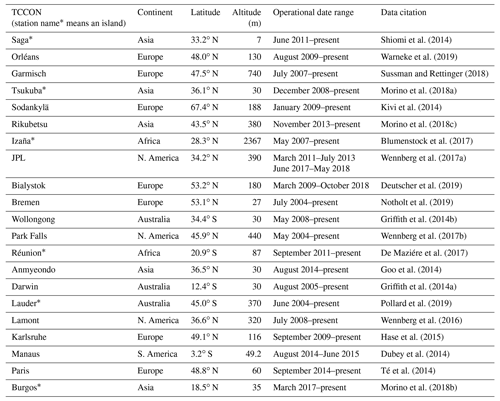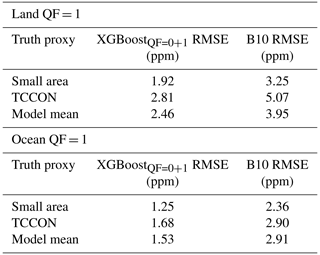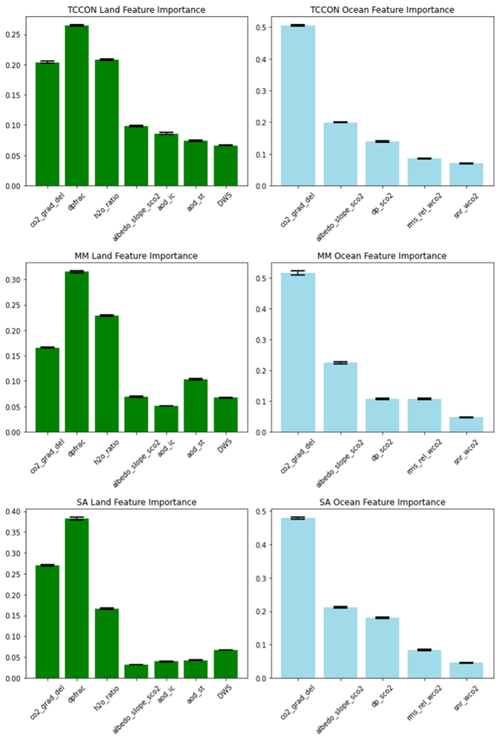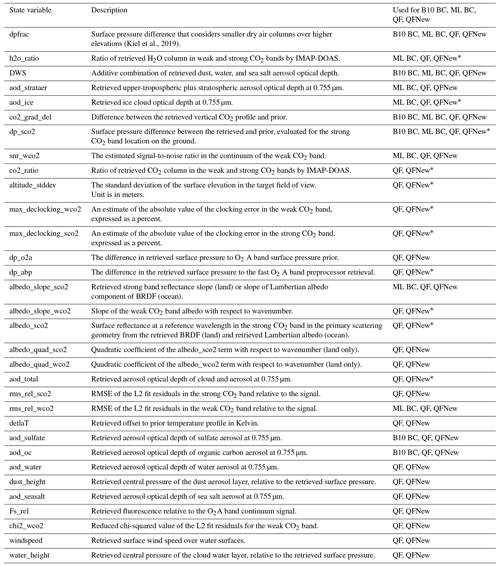the Creative Commons Attribution 4.0 License.
the Creative Commons Attribution 4.0 License.
A nonlinear data-driven approach to bias correction of XCO2 for NASA's OCO-2 ACOS version 10
Steffen Mauceri
Sean Crowell
Christopher W. O'Dell
Measurements of column-averaged dry air mole fraction of CO2 (termed XCO2) from the Orbiting Carbon Observatory-2 (OCO-2) contain systematic errors and regional-scale biases, often induced by forward model error or nonlinearity in the retrieval. Operationally, these biases are corrected for by a multiple linear regression model fit to co-retrieved variables that are highly correlated with XCO2 error. The operational bias correction is fit in tandem with a hand-tuned quality filter which limits error variance and reduces the regime of interaction between state variables and error to one that is largely linear. While the operational correction and filter are successful in reducing biases in retrievals, they do not allow for throughput or correction of data in which biases become nonlinear in predictors or features. In this paper, we demonstrate a clear improvement in the reduction in error variance over the operational correction by using a set of nonlinear machine learning models, one for land and one for ocean soundings. We further illustrate how the operational quality filter can be relaxed when used in conjunction with a nonlinear bias correction, which allows for an increase in sounding throughput by 14 % while maintaining the residual error in the operational correction. The method can readily be applied to future Atmospheric CO2 Observations from Space (ACOS) algorithm updates, to OCO-2's companion instrument OCO-3, and to other retrieved atmospheric state variables of interest.
- Article
(8037 KB) - Full-text XML
- BibTeX
- EndNote
Carbon dioxide (CO2) is a key contributor to radiative forcing, and hence rising levels in the atmosphere are of concern due to their influence on future climate. Following a long history of critical in situ measurements of CO2 at key sites around the world that allowed us to better understand the carbon cycle on continental scales, the era of space-based remote sensing began with the Scanning Imaging Absorption Spectrometer for Atmospheric Chartography (SCIAMACHY) in March 2002 (Bovensmann et al., 1999) and the Atmospheric Infrared Sounder (AIRS) launched in May 2002 (Aumann et al., 2003). These missions were followed by dedicated CO2 observers such as the Greenhouse gases Observing SATellite (GOSAT) mission in 2009 (Kuze et al., 2009) and the Orbiting Carbon Observatory-2 (OCO-2) in 2014 (Crisp et al., 2004). These data have yielded substantial scientific insights, such as a much more dynamic tropical carbon cycle compared with previous understanding (e.g., Liu et al., 2017; Palmer et al., 2019; Crowell et al., 2019; Peiro et al., 2022), as well as studies into power plant emissions and plumes (Nassar et al., 2017).
OCO-2 measures reflected solar radiances, from which column-averaged CO2 dry air mole fractions (XCO2) are retrieved with the NASA Atmospheric CO2 Observations from Space (ACOS) algorithm (Crisp et al., 2012; O'Dell et al., 2012; Connor et al., 2008). Radiances are measured in the near-infrared oxygen A band near 0.76 µm, the shortwave infrared weak CO2 band near 1.6 µm, and the shortwave infrared strong CO2 band near 2.05 µm. ACOS is based on Bayesian optimal estimation (Rodgers, 2000) that adjusts input parameters (e.g., XCO2, aerosols, surface characteristics, surface pressure) to maximize agreement between a modeled spectrum (derived by a radiative transfer model) and OCO-2 measurements. The parameters that best explain the measured radiances are labeled as the “retrieved” parameters. ACOS has undergone continuous improvement since the initial version.
Since the radiances contain uncorrected calibration artifacts and the modeled representation of the atmospheric radiative transfer is not perfect, retrieved parameters contain systematic biases. The inverse problem is under-constrained and leads to posterior errors in retrieved parameters that are correlated. To correct for errors in XCO2 arising from these types of dependencies, a multiple linear regression (MLR) bias correction with co-retrieved state variables or features used as predictors is fit to the difference (ΔXCO2) between the ACOS-retrieved XCO2 and a truth proxy estimate of XCO2. This method was first introduced for ACOS retrievals applied to the GOSAT instrument (Wunch et al., 2011) and later extended to OCO-2 and OCO-3 (O'Dell et al., 2018; Taylor et al., 2020, 2023). The MLR bias correction is fit in tandem with a quality filter of empirically defined thresholds on a set of features. The bias correction and quality filter are derived iteratively, with filter thresholds chosen restricting features to a range in which the relationship between ΔXCO2 and the parameters are mostly linear, improving the goodness of fit for the multilinear regression, which is then used in turn to retune the quality filter thresholds. The combined bias correction and quality filtering process is derived manually so that the final product must be hand-tuned for each algorithm update. After the feature-based correction, a footprint correction and global Total Carbon Column Observing Network (TCCON) offset are applied. The combined bias correction and quality filter process is robust across a set of ground truth proxy metrics and greatly reduces both mean bias and error scatter of XCO2 retrieved from OCO-2. Full details of the operational bias correction and filtering can be found in O'Dell et al. (2018).
A drawback of applying the quality filter is the exclusion of data due to the linear assumption of the bias correction to which the quality filter limits the regime of interaction between state vector variables and ΔXCO2, thus removing data where the bias is nonlinear. Due to loss of data, the bias correction and quality filter are often disregarded for local studies (Nassar et al., 2017; Mendonca et al., 2021) and are too limiting for certain regions (Jacobs et al., 2020). Applying nonlinear machine learning techniques has shown great promise for the task of bias correction for GOSAT and GOSAT-2 (Noël et al., 2022) and TROPOMI (Schneising et al., 2019). Specific correction of 3D cloud biases for OCO-2-retrieved XCO2 (Massie et al., 2016) using a nonlinear method fit on a small set of features correlated with 3D cloud effects in addition to the linear operational correction is demonstrated in Mauceri et al. (2023).
This research demonstrates a general nonlinear bias correction approach for OCO-2 build 10 (B10; Taylor et al., 2023) via a machine learning method and provides a post hoc explanation of the overall contribution of the selected state vector features. Our nonlinear bias correction is shown to reduce systematic errors and increase the percentage of good-quality soundings by allowing for the relaxation of the hand-tuned thresholds employed with the standard quality threshold method. The framework presented in this paper for identifying informative features for bias correction can be adapted for future OCO-2 and 3 ACOS algorithm updates.
To develop a bias correction, we define three truth proxy datasets for the true atmospheric column mole fraction. ΔXCO2 is then set as the difference between the raw ACOS retrieval of XCO2 and the truth proxy estimate of XCO2, as shown in Eq. (1). For the TCCON and model mean truth proxies, the OCO-2 averaging kernel is also applied as described in Taylor et al. (2023).
We use the same proxy datasets used in the development of the operational bias correction (Osterman et al., 2020): co-located OCO-2 soundings with TCCON, a collection of small area clusters of soundings for which XCO2 is not expected to vary above the instrument noise, and a set of modeled mole fractions whose underlying surface flux is constrained by the NOAA global in situ network (Masarie et al., 2014). Datasets include soundings from November 2014 through to February 2019. Each truth proxy captures a different scale of retrieval error and as such gives complementary information as described in O'Dell et al. (2018). All datasets were sampled in conjunction with corresponding locations and times in the OCO-2 B10 L2 Lite files which can be found at https://disc.gsfc.nasa.gov/datasets/ (last access: 10 January 2022). Spatial coverage and sounding count are shown in Fig. 1. The newest version available, the level 2 product, is build 11 (B11); however at the time of writing it was undergoing reprocessing.
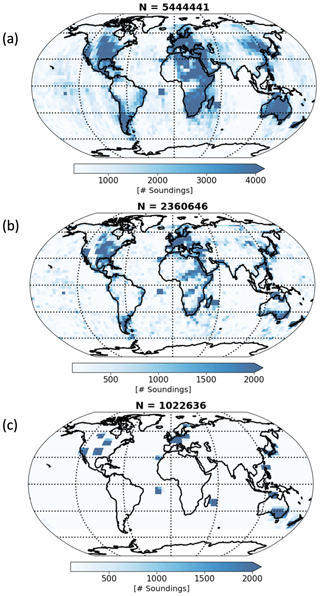
Figure 1Spatial coverage for each truth proxy. The mean of a set of flux models is shown in panel (a), small area approximation is shown in panel (b), and TCCON is shown in panel (c).
2.1 TCCON truth proxy
TCCON is a system of ground-based sun-looking Fourier transform spectrometers with growing global coverage that retrieves column-averaged dry air mole measurements of the trace greenhouse gases from radiances in similar spectral bands to OCO-2. Since each site has been extensively validated against World Meteorological Organization (WMO)-traceable in situ observations on board aircraft, TCCON offers the most accurate comparison for XCO2 (Wunch et al., 2010). While TCCON is well calibrated, site coverage is limited outside of North America, Europe, and Oceania. The TCCON dataset therefore is spatially the sparsest of the three truth proxies and offers non-uniform point comparisons. We use the same dataset as the operational correction consisting of OCO-2 soundings co-located with TCCON GGG2014 measurements (Wunch et al., 2017, 2011) in space (2.5∘ lat, 5∘ long) and time (2 h). The stations used in this work are shown in Table 1.
2.2 Small area approximation truth proxy
The small area approximation described in O'Dell et al. (2018) offers insight into small-scale drivers of bias and retrieval variability. The small area approximation truth proxy assumes that XCO2 within a 100 km neighborhood is largely uniform for a given overpass by OCO-2. This assumption is evaluated in Worden et al. (2017), where it was found by using a high-resolution atmospheric model (GEOS-5) that variance of XCO2 is around 0.1 ppm per 100 km. The proxy offers improved spatial coverage compared to TCCON but struggles to capture biases with low variability over the small area.
2.3 Flux models truth proxy
A set of flux inversion models form the largest of the truth proxy datasets, both in number of soundings and in spatial coverage. The models included in this truth proxy set are found in Table 2. The posterior XCO2 fields produced by the models are sampled along OCO-2 tracks; the proxy is then computed as the average of the models at every sounding where there is good agreement (within 1.5 ppm) among models (O'Dell et al., 2018; Osterman et al., 2020).
3.1 Gradient boosting
To model systematic error from co-retrieved state vector elements, we employ a machine learning method known as extreme gradient boosting or XGBoost (Chen and Guestrin, 2016) which can fit both linear and nonlinear relationships. XGBoost is an ensemble model where a set of simple models known as regression trees (Breiman 1984) are sequentially trained, with each new member fit on residuals of the previous trees. During inference, the weighted sum is taken across the ensemble members. Members are grown or fit by selecting features that provide high information gain (Eq. 2). Information gain is calculated by evaluating the sum of the gradients G and hessians H of the loss function at left and right leaf nodes when selecting split points for a feature during tree fitting. For our experiments we minimize the mean squared error between the truth proxy bias yi and the estimate as the loss function, as shown in Eq. (3). Features that are informative for reducing residual error during tree development yield high gain values. These values can be summed across trees in the ensemble to produce a ranking of feature contribution. This provides a post hoc method of interpretability yielding a high level or global view of feature importance to correcting ΔXCO2. While this method of interpretability is less informative than the regression coefficients provided by a linear model, it is useful for tasks such as feature selection.
XGBoost employs L1 and L2 norm regularization to reduce overfitting to outliers present in the training dataset. The effect of the regularization is governed by the hyperparameters λ and γ and must be carefully selected or tuned. To find these hyperparameters we use a k-fold cross validation strategy in which the training dataset is divided into k subsets (we use k=10) and each subset is sequentially held out for evaluation for a model trained on the rest of the data. Performance across the k folds is averaged, and the process is repeated for each potential selection of hyperparameters. We found a λLAND=2.5 and γLAND=3.75 for the land correction and λOCEAN=2.0 and γOCEAN=10.0.
3.2 Quality filtering
Soundings of the lowest quality are typically caught by the O2 A band preprocessor (Taylor et al., 2012) and IMAP-DOAS (Frankenberg et al., 2005) algorithms due to clouds and low SNR in the continuum and are then screened out before being run through the L2 retrieval algorithm (Taylor et al., 2016). After retrieval, an additional number of soundings are flagged and removed for which the ACOS algorithm failed to converge or for which the chi-squared difference between modeled and measured spectra is too large. Additionally, large unphysical outliers present in the tails of the conditional distributions of several atmospheric state variables are also removed by hand using domain-expert-selected thresholds. Finally, users can select for high-quality retrievals using the binary XCO2 quality flag (QF) with “good” data having a QF = 0 and “poor” data having QF = 1. The operational XCO2 quality flag is derived using a set of filters applied to the state vector variables found in conjunction with linear parametric bias correction. An initial linear correction is fit on soundings that have passed the preprocessing filtering steps. Each filter is then hand selected, QF = 1 data are removed, and the bias correction is re-fit until a final set of filters and linear model weights are derived that sufficiently reduce mean bias and scatter (O'Dell et al., 2018).
To assess the ability of the nonlinear method to correct QF = 1 data and the potential for increased throughput of well-corrected data, we derive a new quality flag (QFNew). Our flag is developed in a similar fashion to the B10 quality flag for use with the nonlinear correction. The first step is to start with the same set of state vector variables and associated thresholds. Next, thresholds are relaxed for a selection of state vector variables that allow for higher sounding throughput while maintaining or reducing corrected ΔXCO2 across truth proxies. Thresholds are never set to be more constraining than the B10 values in order to not remove soundings that are already considered to be of passing quality.
3.3 Training and test split
For training and evaluating the nonlinear correction, we subset each of our truth proxy datasets into training and testing datasets. First, datasets are split by the two surface types: ocean and land. In B10, both operation modes (nadir and glint) are combined for the land bias correction due to low variance in feature importance between nadir and glint (O'Dell et al., 2018). To compare to the operational correction, we also combine both modes for the land correction model. The land and ocean datasets are subset once more by truth proxy to identify informative features for the final land and ocean models. To ensure that model performance is indicative of how well the models generalize to unseen data, we hold out a year of data for evaluation of the final land model and ocean model. Models are trained on data from 2014, 2015, 2016, and 2017 and then evaluated on data from 2018. Since data from 2019 are limited, we exclude them from both training and evaluation.
3.4 Experiment design
First, the footprint correction as described in O'Dell et al. (2018) is applied to the training and evaluation datasets. We then evaluate two methods for bias-correcting retrieved XCO2: a nonlinear machine learning model called XGBoost and, as a baseline, an MLR model trained similar to the hand-tuned model used in the operational correction. For correcting land nadir and land glint data, a single XGBoost model and MLR are trained using all three truth proxies. The predictor variables or features are the same for both model types. This allows for comparison between the nonlinear model and baseline linear method to properly assess that improved fit is coming from the captured nonlinearity and not just the inclusion of the additional predictors. A single XGBoost and MLR are derived for correcting ocean glint data, again using all three proxies and the same set of ocean features. We also compare our approach to the operational land correction and ocean correction for B10.
To identify a set of informative features to be used as inputs for the XGBoost land and ocean models, we first train a set of models independently on each truth proxy. These six models (three for land and three for ocean) are initially fit on a large set of potentially informative features, using QF = 0 + 1 data. The resulting feature importance derived from these initial models is used to filter down the feature set to identify a subset of features that is highly informative across truth proxies. The resulting feature sets are combined to train the final proposed model pair (one for land and one for ocean), which are trained using all truth proxies.
Next, we compare the final models trained on QF = 0 + 1 data against models trained only on good-quality data assigned QF = 0 and then evaluate each model pair on QF = 0 soundings that have been temporally held out. This is to ensure the ability of the nonlinear method to reproduce the linear model, which is the currently accepted community standard. Secondly, we evaluate the model trained on QF = 0 + 1 data on the excluded regime of data labeled QF = 1, where nonlinear relationships between ΔXCO2 and predictors become more pronounced. Finally, we derive a new quality flag (QFNew) used in conjunction with the nonlinear correction that increases the throughput of well-corrected data while maintaining similar error metrics as the operational filter and correction.
4.1 Feature selection
We select informative features for our bias correction following an iterative procedure. In the first step, we train XGBoost models for each proxy by surface type and operation mode (six models in total). These initial models are trained using a large subset of co-retrieved state vector variables (shown in Table C1) which are potentially informative for correcting ΔXCO2 from the B10 L2 Lite files. The resulting models are used to rank features according to their information gain, which is defined in Eq. (2). Features that are less informative are removed from the set, and new models are trained with the reduced feature set. Afterwards, feature importance is once again evaluated. To ensure robustness to correlation among features (which information gain does not account for), we calculate Pearson's correlation values between features. Features with an absolute Pearson value greater than 0.5 are included one a time, and the feature with the highest importance is kept. This process is iteratively repeated until reaching a relatively small subset of maximally informative features. These features are combined to train the final bias correction models, which are trained on all proxies. Seven features are selected for land correction and five features for ocean, as shown in Fig. 2. The resulting features used in the final models and a brief description are shown in Table 3.
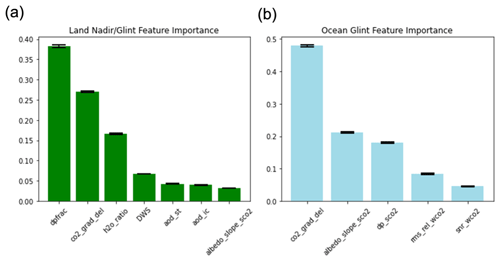
Figure 2Feature importance for final land model trained with all proxies (a). Feature importance for final ocean model trained with all proxies (b). Error bars denote variance in feature importance across 10 runs with different random seeds.
Table 3Selected features for use in our bias correction models. The first column shows state vector variable names as defined in the B10 L2 files, the second provides a brief description, and the last column shows which region and viewing mode correction the variable is used for. NG signifies nadir plus glint and G glint.
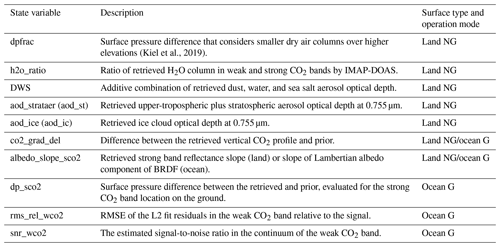
Features used for the operational correction are also highly informative for the proposed nonlinear corrections and include the difference between the retrieved CO2 profile and prior profile used for land and ocean (co2_grad_del), as well as two surface pressure difference terms: dpfrac for land and dp_sco2 for ocean (Kiel et al., 2019). The co2_grad_del is the change in profile shape and the prior and is calculated as the difference in dry air mole fraction at the surface, denoted as CO2(1), from the fraction at ∼ 0.6316 times the retrieved surface pressure; it is in units of parts per million (ppm). The calculation for co2_grad_del is shown in Eq. (4). For land, the dpfrac term is a difference ratio that considers the smaller dry air column over higher elevations and is defined in Eq. (5), where XCO2,raw is the uncorrected retrieval of the column average and Pap,SCO2 and Pret are the prior surface pressure at the strong band pointing offset and retrieved pressure, respectively. For ocean, dp_sco2 is used and is the retrieved surface pressure minus the strong band prior. The extensive use of co2_grad_del and surface pressure deltas for bias correction is discussed in Kulawik et al. (2019).
For land, the h2o_ratio is used and is the ratio of XH2O estimated by single-band retrievals from the strong and weak CO2 bands separately using the IMAP-DOAS algorithm, which can differ from unity in the presence of atmospheric scattering (Taylor et al., 2016). We use three aerosol features for our bias correction over land scenes, the first being the sum of dust, water, and sea salt optical thickness termed DWS. We include retrieved ice particle optical depth (aod_ice) and the finer stratospheric aerosol optical depth (aod_strataer). The last feature used for land, as well as for ocean, is the albedo slope for the strong CO2 band termed albedo_slope_sco2. This variable represents the slope of the reflectance across the strong CO2 spectral band for land soundings and the slope of the Lambertian component of the combined Cox–Munk and Lambertian Bidirectional Reflectance Distribution Function (BRDF) for ocean soundings (Cox and Munk, 1954). In addition to the co2_grad_del, albedo_slope_sco2, and dp_sco2, two additional variables are used for the correction of ocean G (glint) scenes. These are snr_wco2, which is the estimated signal-to-noise ratio derived during optimal estimation, and finally rms_rel_wco2, which is the percent residual error from the forward-modeled radiance for the weak CO2 to the measured radiance.
4.2 Model evaluation for QF = 0
To ensure that the nonlinear method generalizes the linear relationships largely observed for QF = 0, we evaluate two XGBoost models – one which is fit on QF = 0 + 1 and one fit on QF = 0 – to an MLR fit on the same feature set as the nonlinear models. As the operational quality flag is hand-tuned by re-fitting an MLR, the regime between the variables selected for correction and systematic error are reduced to mostly linear relationships. The nonlinear method has only a marginal improvement over the MLR and B10 correction on soundings that are passed by the operational quality filter over land (0.02–0.04 ppm) and a slightly more substantial improvement over ocean (0.09–0.10 ppm) on the evaluation data. We found that retraining the XGBoost models on QF = 0 data does not offer a substantial reduction in error despite initial XGBoost models being trained on unfiltered data. We forgo the iterative refitting approach that is required for the MLR and operational correction by training once on QF = 0 + 1 data. Table 4 shows the QF = 0 RMSE results for XGBoost models trained on both QF = 0 + 1 data and QF = 0 data, alongside the MLR model fit to the filtered regime for 2018 and B10 operational correction.
Table 4RMSE scores for 2018 on QF = 0 data. Results are shown for land and ocean data by truth proxy and model. Two XGBoost models are shown: one trained on QF = 0 + 1 (XGBoostQF0+1) data and then evaluated on QF = 0 and another (XGBoostQF=0) trained and evaluated on only QF = 0 data. A multiple linear regression (MLRQF=0) is also fit for QF = 0 using the same feature set. In the last column, RMSE for operationally corrected XCO2 (B10) is shown.

4.3 Correcting outside of the filtered regime
Correction of systematic error outside of the quality-filtered regime (QF = 1) is difficult to fit with a linear model. Strong nonlinearities are observed for many of the co-retrieved state vector variables and ΔXCO2. For many variables this behavior is observed over un-physical values in a few spurious soundings that are easily filtered out. Variables such as h2o_ratio which are responsible for the bulk of the quality filtering (h2o_ratio thresholds remove ∼ 10 % of soundings) exhibit such nonlinear characteristics over their marginal distributions. The dependent linear correction and quality filter is prohibitive for correcting and passing data in these regions of the domain. Figures 3 and 4 illustrate the interaction between state variables chosen for correction and ΔXCO2. The nonlinear model (green) improves both the mean and variance of ΔXCO2 over both the raw ΔXCO2 (red) before correction and B10 correction (blue). Table 5 displays the RMSE scores of the XGBoost-corrected XCO2 and operationally corrected XCO2 for QF = 1 data. The nonlinear correction provides a large improvement in reducing the residual error for QF = 1 data over the operational correction with a 1.33–2.26 ppm improvement for land data and 1.11–1.38 ppm for ocean. These errors are still significantly larger than the corresponding QF = 0 errors.
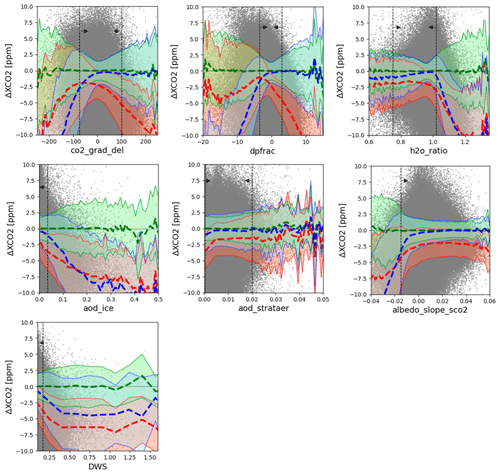
Figure 3ΔXCO2 vs. land features for 2018. Mean interaction and 2σ SD for uncorrected ΔXCO2 plotted in red, XGBoost corrected in green, and B10 corrected in blue. The vertical black dotted lines indicate B10 QF filters, and arrows point towards the region assigned QF = 0. Individual soundings are shown with gray scatter.

Figure 4ΔXCO2 vs. ocean features for 2018. Mean interaction and 2σ SD for uncorrected ΔXCO2 plotted in red, XGBoost corrected in green, and B10 corrected in blue. The vertical black dotted lines indicate B10 QF filters, and arrows point towards the region assigned QF = 0. Individual soundings are shown with gray scatter.
4.4 Comparison to B10
For the operational correction, regression weights for the linear model are hand-selected that have good agreement in their correction across truth proxies. The full operational correction also includes a fixed correction for each of OCO-2's eight footprints, as described in Osterman et al. (2020). To provide a fair comparison between the full correction models, we also apply the footprint correction after applying the nonlinear feature correction. Table 6 shows the mean and 1σ standard deviation for each bias correction and QF regime. The largest improvement in the nonlinear method over B10 comes when correcting QF = 1 data, achieving a 59 % improvement in the reduction of error variance for land and a 67 % improvement for ocean data. The improvement in correction over B10 is less significant for QF = 0 with improvement of 8 % for land and 19 % for ocean.
Table 6Comparison of combined proxy mean and standard deviation XGBoost-corrected XCO2, XCO2 after the operational correction (B10), and un-corrected XCO2 (raw) for 2018 and all QF filter regimes for both land and ocean data.

Regionally, the nonlinear correction shows up to a 0.5 ppm improvement over northern Africa, where the B10 correction appears to underestimate ΔXCO2 in comparison. A reduction in biases is also observed in large parts of South America's tropical and subtropical regions, as well as parts of tropical Asia shown in Fig. 5a. These regions also contain the largest difference in land NG (nadir plus glint) correction between the methods with an average difference (B10 − XGBoost) of −0.5 ppm. There is a slight positive difference between methods over the Amazon Basin and Congo rainforest (Fig. 5e). Figure 5c and d illustrate the improvement of the nonlinear method to correct QF = 1 data over the operational approach. For QF = 1, where the interaction between features and error is nonlinear, large biases in XCO2 remain after operational correction. The XGBoost model reduces these remaining biases in many regions, indicating that there may still be usable data that are filtered out by the operational QF when paired with the nonlinear correction.

Figure 5Remaining XCO2 biases (ΔXCO2) after correction for 2018 and model mean proxy, binned to a 3∘ × 3∘ resolution. ΔXCO2 after the XGBoost correction for QF = 0 is shown in panel (a), ΔXCO2 after the B10 correction for QF = 0 is shown in panel (b), ΔXCO2 after the XGBoost correction for QF = 1 is shown in panel (c), ΔXCO2 after the B10 correction for QF = 1 is shown in panel (d), and the difference (B10 − XGBoost) for QF = 0 is shown in panel (e).
4.5 Increased sounding throughput
One of the benefits of the nonlinear bias correction is the potential for increased throughput of well-corrected QF = 1 data. Improved throughput of well-corrected data would be of benefit to point analysis studies where data are limited by the operational QF and potentially of benefit to flux models as well. To provide an empirical example of this, we create a modified version of the operational XCO2 quality flag utilizing our proposed ocean correction model and land correction model. We take a conservative approach where initial filter values are set equal to those of the operational quality filtering. Then, we select a few variables for which the filters are relaxed to increase sounding throughput while maintaining the RMSE of the combined operational correction and quality filter. With our new quality flag (QFNew), we are able to increase sounding throughput by approximately 14 % over the B10 QF while matching the RMSE of the B10 correction, as shown in Table 7.
Table 7RMSE for combined XGBoost correction, B10 QF percent data throughput, and QFNew percent data throughput by surface and mode for 2018.

For many features, the quality filters were not changed from the operational filters, as relaxing filters on variables that are already passing most of their conditional distributions would allow for only marginal improvements in throughput at the cost of large systematic errors. Therefore, we select only features for which large portions of the marginal distributions are removed by the operational flag and where the nonlinear correction improves both the mean and variance of ΔXCO2. The relaxed filters for these variables are shown in Figs. B1 and B2 by the vertical red dashed lines, and the range of data assigned QFNew = 0 is shown in the red parentheses. The operational filter also minimizes the unitless metric of the binned standard deviation of ΔXCO2 divided by the posterior XCO2 uncertainty below a value of 3 ppm ppm−1 (Osterman et al., 2020). When tuning QFNew, we also aim to minimize this metric. Higher throughput of well-corrected data is observed in northern and central Africa, the Amazon Basin, and in latitudes above 60∘ N as seen in Fig. 6. While the selection of these variables and the relaxation of their filter values are subjective, this empirical result illustrates the benefit of a quality flag derived in conjunction with the nonlinear bias correction. Future work will focus on the automation of defining the quality flag thresholds using a data-driven approach.
5.1 Generalization across proxies
We acknowledge that even with a temporal training and testing split, there is still some circularity due to the lack of a truly independent truth proxy. This issue has been discussed at length for the operational bias correction in Taylor et al. (2023), and the comparison and selection of independent validation datasets are still an open area of study. The risk of overfitting due to circularity becomes greater when fitting a more complex machine learning model. To evaluate generalizability to a fully independent validation proxy, we fit a set of XGBoost models on two truth proxies and evaluate on the third proxy which is held out during training. The same temporal split is used where 2018 data for the held-out proxy are used for evaluation. Results are shown in Fig. 7, for land, and Fig. 8, for ocean. Each column shows the residual fit for the hold-out proxy for QF = 0 (top row) and QF = 1 (bottom row). For QF = 0, increase in RMSE was minimal for both surface types and across proxies. There was some impact to performance on QF = 1 data when compared to training with all three proxies, particularly for TCCON with an increase in RMSE of ∼ 0.1 ppm for land and ocean data, indicating that the information contained in TCCON is not adequately represented by the model mean and small area approximation proxies which capture variability at larger scales. A potential approach to reducing circularity in the evaluation of the truth proxies would be to train the bias correction on TCCON and either the model mean or small area approximation using the third proxy not chosen for validation.
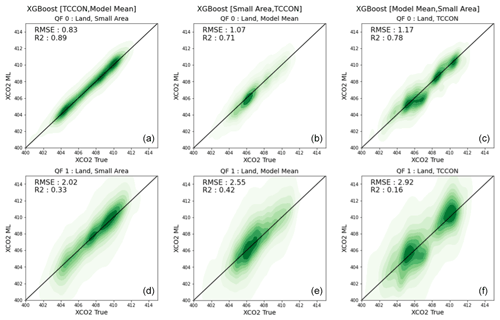
Figure 7Comparison of XCO2 derived from XCO2 corrected by XGBoost (XCO2 ML) vs. truth proxy (XCO2 True) for land by the hold-out proxy set and hold-out year (2018). Panels (a) and (d) display results of a XGBoost model trained on [TCCON, Model Mean] and evaluated on Small Area. Panels (b) and (e) display results of a XGBoost model trained on [Small Area,TCCON] and evaluated on Model Mean. Panels (c) and (f) display results of a XGBoost model trained on [Model Mean, Small Area] and evaluated on TCCON. Generalization for the hold proxy and QF = 0 is shown in the top row and QF = 1 in the bottom.
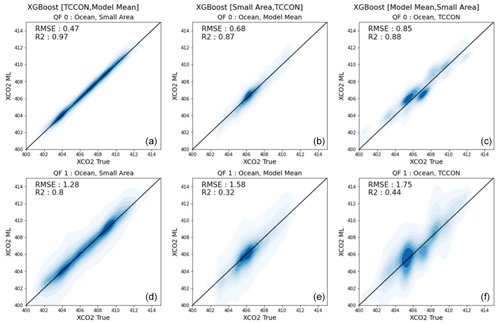
Figure 8Comparison of XCO2 derived from XCO2 corrected by XGBoost (XCO2 ML) vs. truth proxy (XCO2 True) for ocean by the hold-out proxy set and hold-out year (2018). Panels (a) and (d) display results of a XGBoost model trained on [TCCON,Model Mean] and evaluated on Small Area. Panels (b) and (e) display results of a XGBoost model trained on [Small Area,TCCON] and evaluated on Model Mean. Panels (c) and (f) display results of a XGBoost model trained on [Model Mean, Small Area] and evaluated on TCCON. Generalization for the hold proxy and QF = 0 is shown in the top row and QF = 1 in the bottom.
5.2 Evaluating feature importance between filter regimes
To understand the contribution of the features to correcting bias in QF = 0 and QF = 1 data, we compare the information gain between the two regimes. To perform the ablation study, we again employ the models trained on individual truth proxies and retrain and evaluate them on QF = 0 and again on QF = 1 data. Figure 9 shows the information gain for each filter regime for land and for ocean. For land, dpfrac and co2_grad_del are highly informative for correction of QF = 0 data by the machine learning model. Similarly for ocean QF = 0 data, the surface pressure delta term dp_sco2 and co2_grad_del are also highly informative. In operation, these terms are also used for bias correction in all ACOS versions (dpfrac replaced dP in build 9, B9) to date. These variables are responsible for the largest reduction in unexplained variance in the filtered regime (Payne et al., 2022; Osterman et al., 2020; O'Dell et al., 2018).

Figure 9Feature importance for land is shown in panel (a), and feature importance for ocean is shown in panel (b). Y axis displays the normalized information gain from XGBoost models, with QF = 0 shown in darker colors and QF = 1 shown in lighter colors.
For land QF = 1 data, there are a drop in importance for co2_grad_del and dpfrac, a large increase for h2o_ratio, and relative increases for the albedo and aerosol terms. To explain the high importance for the h2o_ratio, we look to the nonlinear interaction outside of the bound imposed by the operational filter which removes soundings with a h2o_ratio greater than 1.023, reducing the regime of interaction to one that is not highly correlated with ΔXCO2. In the QF = 1 regime, h2o_ratio corresponds to a significant negative bias. Larger values of h2o_ratio are explained in Taylor et al. (2016), where it was shown that retrieved surface albedo from the strong CO2 band is generally lower than the weak CO2 band. In cases of larger aerosol presence, this sensitivity leads to weakening of the absorption features and a positive departure from unity. The additional albedo term for the strong CO2 band and the additional aerosol terms also increase in importance for QF = 1.
For ocean QF = 1 data, there is a significant change in information gain for several features. The surface pressure delta term dp_sco2 becomes significantly less informative for correcting QF = 1, where negative values of dp_sco2 are relatively uncorrelated with ΔXCO2. Similarly to land, the albedo term for the strong CO2 band is more informative for correcting outside the filtered regime along with the residual error between forward-modeled radiances and measurements in the weak CO2 band.
5.3 Preservation of CO2 enhancements
We assess the risk of the proposed bias correction to correct and remove plume features in the data. Several features heavily utilized by the XGBoost models and in operational correction, such as the CO2 gradient delta and surface pressure terms (e.g., dpfrac, dp_o2a), are differences between the ACOS-retrieved state and the prior. Therefore, there is potentially a risk for the bias correction to use the delta terms to overcorrect the retrieved XCO2 to the truth. We compare XGBoost-corrected XCO2 for two known plumes first identified in Nassar et al. (2021). The two example plumes are shown in Fig. 10a and b: an ocean glint and land nadir plume in Taean, South Korea, and a land nadir plume observed over two co-located power plants in Ohio, USA. We compare the uncorrected XCO2 retrieval (B10 raw), the operationally corrected XCO2 (B10 corrected), and the machine-learning-corrected XCO2 (XGBoost corrected) and note that the machine-learning-corrected product captures enhancements not present in the training data. These results are also consistent with the findings in Mauceri et al. (2023), which include similar delta terms. This is further illustrated with the Taean plume which consists of ∼ 35 % QF = 0 soundings and ∼ 65 QF = 1 soundings. QFNew = 0 improves the passing rate to ∼ 60 %, as shown in Fig. 10c. The red stars show data that are passed by QF = 0 (and by construction QFNew = 0), and the blue stars show data that would be removed by QF = 1 but are passed by QFNew = 0, indicating where the increase in available data for the plume feature is. Of particular interest is the increase in data within the feature around 36.95∘, which includes maximum observed enhancement value.

Figure 10Two CO2 plumes captured downwind from power plants (Nassar et al., 2021). A land nadir plume near the J. M. Gavin and Kyger Creek power plants in Ohio, USA (lat 38.93∘, long −82.12∘), on 30 July 2015 (a). An ocean glint and land nadir plume at Taean, South Korea (lat 36.91∘, long 126.23∘), on 17 April 2015 are shown in panel (b). Regions with the example plumes are not present in the training dataset and consist of QF = 0 + 1 data. Panel (c) shows the increase in XGBoost-corrected data for QFNew = 0 that would be filtered by the B10 QF.
5.4 Potential for further improving data throughput
Figure 11 further illustrates how the shape of the filtering or decision surface can affect data throughput. Soundings are binned by two state vector features: h2o_ratio and dpfrac. Figure 11b and d show the improvement in the reduction of mean ΔXCO2 and of the error divided by the posterior uncertainty from the nonlinear correction. The QF filters for each feature are indicated by the black dashed lines, and the interior of the intersection of these filters indicates the region of state space that is labeled as QF = 0 (note: the additional filters of the QF further reduce the data that are passed in this region). Significant portions of the distribution, which the nonlinear method can accurately correct, lay outside of this filtered region and are labeled QF = 1. A data-driven filter can be constructed using similar interpretable machine learning techniques and produce a unified correction and filtering product. Furthermore, moving away from the binary quality flag to a ternary (“very good”, “good”, “bad”) will likely provide an improved data product for end users. Data-driven methods for quality filtering have already proven to be useful in the northern high latitudes (Mendonca et al., 2021), and a genetic algorithm was previously used to derive the “warn levels” which complement the operational quality flag found in early OCO-2 data versions (Mandrake et al., 2015). An important task for such future work will be to ensure that the machine learning method learns a physically consistent filter that can increase data throughput while still limiting variance of error and ΔXCO2. We also acknowledge that while the Taean plume shown in Fig. 10 illustrates an empirical example of the ability of a nonlinear correction to improve throughput of good-quality data, further evaluation of the intersection (QF = 1 and QFNew = 0) will be required before bringing such a method to operation.

Figure 11Hex bin plots show conditional distributions of 2018 ΔXCO2 vs. dpfrac and h2o_ratio. Remaining ΔXCO2 after the operational correction for B10 is shown in panel (a). Remaining ΔXCO2 after the nonlinear correction is shown in panel (b). Binned SD of ΔXCO2 divided by the posterior uncertainty from the retrieved XCO2 is shown in panel (c) for the operational correction for B10 and panel (d) for the nonlinear correction. B10 QF filter thresholds for both features are shown with black dashed lines for reference.
We demonstrate an approach for selecting co-retrieved state vector variables and other features to be used as input for a land model and an ocean model to correct biases in ACOS-retrieved XCO2. The use of the nonlinear method allows for decoupling of the dependent bias correction and filter used in operation, as the filter no longer needs to limit the correction function to a linear fit. By doing so, this method achieves a 59 % and 67 % improvement in the reduction of the error variance over the operational correction on QF = 1 data for land and ocean, respectively. To utilize this improvement in correction, we derive a new quality flag (QFNew) by relaxing select filter thresholds from the operational quality flag. Using the proposed QFNew flag, we increase data throughput by 14 % while maintaining a comparable residual error to the operational B10 correction. The workflow outlined in this research is extendable to future ACOS algorithm updates and OCO-2's companion instrument, OCO-3, on board the International Space Station.
To assess the robustness of our choice of features, we compare the ranking produced by the information gain feature importance generated by the gradient booster with the ranking produced by a method called permutation feature importance (Fisher et al., 2018). Permutation feature importance captures the contribution to residual error when a feature has its values randomly shifted across observations. Permutation feature importance is a model-agnostic post hoc method that does not require the bias correction model to be retrained. In Fig. A1 we compare the normalized rankings for the individual proxy/surface/mode models that were used to select variables for the final bias correction models trained on all truth proxies. Good agreement is observed in both the overall ranking and magnitude of normalized feature importance between both methods.
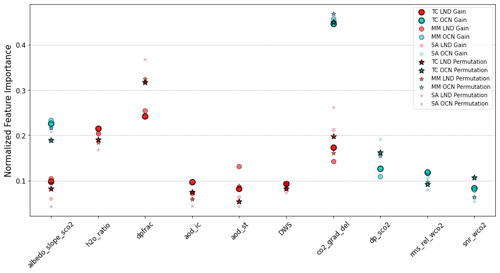
Figure A1Comparison of feature importance derived from information gain and permutation importance. Normalized importance (permutation importance in stars and information gain in circles) is shown for land and ocean features and by truth proxy. The feature importance produced by both methods is largely in agreement in ranking and overall contribution.
The feature importance from the models trained on individual proxies and QF = 0 + 1 data was used to identify state variables to be used as input for the proposed bias correction models. While there is generally good agreement between the proxies, the overall magnitude and ranking differ slightly, as shown in Fig. A2. For TCCON the aerosols and albedo terms contribute more to the correction, while the same terms are less informative for the small area approximation, which is likely due to the small area proxy capturing biases that vary slowly over larger scales. For ocean, the albedo_slope_sco2 is informative for the small area proxy, and all proxies exhibit better agreement in their feature importance.
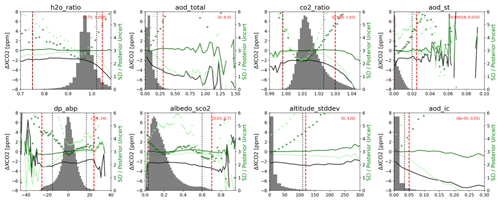
Figure B1Variables selected for land QFNew: the difference between the uncorrected retrieval and the model mean truth proxy is shown with the black curve. The difference between the operational correction and the model mean truth proxy is shown in the light green curve. The difference after the nonlinear correction is shown by the dark green curve. The binned SD error divided by the posterior uncertainty of XCO2 is shown by the green pluses and right y axis. B10 QF filters are indicated by the vertical black dashed lines, and QFNew is shown by the red dashed lines. Region of data denoted as QFNew = 0 is contained within the red values in the parentheses.

Figure B2Variables selected for ocean QFNew: the difference between the raw uncorrected retrieval and the model mean truth proxy is shown with the black curve. The difference between the operational correction and the model mean truth proxy is shown by the light blue curve. The difference after the nonlinear correction is shown by the dark blue curve. The binned SD error divided by the posterior uncertainty of XCO2 is shown by the blue pluses and right y axis. B10 filters are indicated by the vertical black dashed lines, and a potential filter is shown by the red dashed lines. Region of data denoted as QFNew = 0 is contained within the red values in the parentheses.
OCO-2 B10 Lite files can be found at https://doi.org/10.5067/E4E140XDMPO2 (OCO-2 Science Team et al., 2020). The proposed quality filter dataset is available at https://doi.org/10.17605/OSF.IO/CX53S (Keely, 2023).
WRK conducted the experiments and formulated the manuscript and figures. CO'D prepared and provided the truth proxy datasets used. SM, SC, and CWO'D provided significant conceptual input for experiment design and analysis of results. All authors provided thorough review and comments on the final paper.
The contact author has declared that none of the authors has any competing interests.
Publisher's note: Copernicus Publications remains neutral with regard to jurisdictional claims made in the text, published maps, institutional affiliations, or any other geographical representation in this paper. While Copernicus Publications makes every effort to include appropriate place names, the final responsibility lies with the authors.
The authors would like to thank the institutions that provide data from the TCCON instruments, as well as the OCO-2 algorithm and science teams at CSU/CIRA and JPL. CarbonTracker results were provided by NOAA ESRL, Boulder, Colorado, USA, from the website at http://carbontracker.noaa.gov (last access: 10 January 2022).
This research has been supported by the National Aeronautics and Space Administration (grant nos. 80LARC17C0001 and 80NM0018D0004).
This paper was edited by Ilse Aben and reviewed by two anonymous referees.
Aumann, H. H., Chahine, M. T., Gautier, C., Goldberg, M. D., Kalnay, E., McMillin, L. M., Revercomb, H., Rosenkranz, P. W., Smith, W. L., Staelin, D. H., Strow, L. L., and Susskind, J.: AIRS/AMSU/HSB on the Aqua mission: Design, science objectives, data products, and processing systems, IEEE T. Geosci. Remote, 41, 253–264, https://doi.org/10.1109/tgrs.2002.808356, 2003.
Blumenstock, T., Hase, F., Schneider, M., Garcia, O. E., and Sepulveda, E.: TCCON data from Iza na (ES), Release GGG2014R1, TCCON data archive, CaltechDATA [data set], https://doi.org/10.14291/TCCON.GGG2014.IZANA01.R1, 2017.
Bovensmann, H., Burrows, J. P., Buchwitz, M., Frerick, J., Nöel, S., Rozanov, V. V., Chance, K. V., and Goede, A.: SCIAMACHY—Mission objectives and measurement modes, J. Atmos. Sci., 56, 127–150, https://doi.org/10.1175/1520-0469(1999)056<0127:SMOAMM>2.0.CO;2, 1999.
Breiman, L.: Classification and Regression Trees, 1st edn., Routledge, New York, https://doi.org/10.1201/9781315139470, 1984.
CAMS (Copernicus Atmosphere Monitoring Service): Validation report for the CO2 fluxes estimated by atmospheric inversion, v18r2, Version 1.0, https://atmosphere.copernicus.eu/sites/default/files/2019-08/CAMS73_2018SC1_D73.1.4.1-2018-v1_201907_v1.pdf (last access: 10 January 2022), 2021.
CarbonTracker: CarbonTracker, NOAA ESRL, https://carbontracker.noaa.gov (last access: 10 January 2022), 2021.
CarboScope: CarboScope, Max Planck Institute for Biogeochemistry, Jena, https://www.bgc-jena.mpg.de/CarboScope (last access: 10 January 2022), 2021.
Chen, T. and Guestrin, C.: XGBoost: A Scalable Tree Boosting System, in: Proceedings of the 22nd ACM SIGKDD International Conference on Knowledge Discovery and Data Mining – KDD”16, ACM Press, New York, New York, USA, 785–794, 2016.
Chevallier, F., Ciais, P., Conway, T. J., Aalto, T., Anderson, B. E., Bousquet, P., Brunke, E. G., Ciattaglia, L., Esaki, Y., Fröhlich, M., Gomez, A., Gomez-Pelaez, A. J., Haszpra, L., Krummel, P. B., Langenfelds, R. L., Leuenberger, M., Machida, T., Maignan, F., Matsueda, H., Morguí, J. A., Mukai, H., Nakazawa, T., Peylin, P., Ramonet, M., Rivier, L., Sawa, Y., Schmidt, M., Steele, L. P., Vay, S. A., Vermeulen, A. T., Wofsy, S., and Worthy, D.: CO2 surface fluxes at grid point scale estimated from a global 21 year reanalysis of atmospheric measurements, J. Geophys. Res., 115, D21307, https://doi.org/10.1029/2010JD013887, 2010.
Connor, B. J., Bösch, H., Toon, G., Sen, B., Miller, C., and Crisp, D.: Orbiting Carbon Observatory: Inverse method and prospective error analysis, J. Geophys. Res., 113, A05305, https://doi.org/10.1029/2006JD008336, 2008.
Cox, C. and Munk, W. H.: The measurement of the roughness of the sea surface from photographs of the sun's glitter, J. Opt. Soc. Am., 44, 838–850, 1954.
Crisp, D., Atlas, R. M., Breon, F. M., Brown, L. R., Burrows, J. P., Ciais, P., Connor, B. J., Doney, S. C., Fung, I. Y., Jacob, D. J., Miller, C. E., O'Brien, D., Pawson, S., Randerson, J. T., Rayner, P., Salawitch, R. J., Sander, S. P., Sen, B., Stephens, G. L., Tans, P. P., Toon, G. C., Wennberg, P. O., Wofsy, S. C., Yung, Y. L., Kuang, Z., Chudasama, B., Sprague, G., Weiss, B., Pollock, R., Kenyon, D., and Schroll, S.: The Orbiting Carbon Observatory (OCO) mission, Adv. Space Res., 34, 700–709, https://doi.org/10.1016/j.asr.2003.08.062, 2004.
Crisp, D., Fisher, B. M., O'Dell, C., Frankenberg, C., Basilio, R., Bösch, H., Brown, L. R., Castano, R., Connor, B., Deutscher, N. M., Eldering, A., Griffith, D., Gunson, M., Kuze, A., Mandrake, L., McDuffie, J., Messerschmidt, J., Miller, C. E., Morino, I., Natraj, V., Notholt, J., O'Brien, D. M., Oyafuso, F., Polonsky, I., Robinson, J., Salawitch, R., Sherlock, V., Smyth, M., Suto, H., Taylor, T. E., Thompson, D. R., Wennberg, P. O., Wunch, D., and Yung, Y. L.: The ACOS CO2 retrieval algorithm – Part II: Global data characterization, Atmos. Meas. Tech., 5, 687–707, https://doi.org/10.5194/amt-5-687-2012, 2012.
Crisp, D., Pollock, H. R., Rosenberg, R., Chapsky, L., Lee, R. A. M., Oyafuso, F. A., Frankenberg, C., O'Dell, C. W., Bruegge, C. J., Doran, G. B., Eldering, A., Fisher, B. M., Fu, D., Gunson, M. R., Mandrake, L., Osterman, G. B., Schwandner, F. M., Sun, K., Taylor, T. E., Wennberg, P. O., and Wunch, D.: The on-orbit performance of the Orbiting Carbon Observatory-2 (OCO-2) instrument and its radiometrically calibrated products, Atmos. Meas. Tech., 10, 59–81, https://doi.org/10.5194/amt-10-59-2017, 2017.
Crowell, S., Baker, D., Schuh, A., Basu, S., Jacobson, A. R., Chevallier, F., Liu, J., Deng, F., Feng, L., McKain, K., Chatterjee, A., Miller, J. B., Stephens, B. B., Eldering, A., Crisp, D., Schimel, D., Nassar, R., O'Dell, C. W., Oda, T., Sweeney, C., Palmer, P. I., and Jones, D. B. A.: The 2015–2016 carbon cycle as seen from OCO-2 and the global in situ network, Atmos. Chem. Phys., 19, 9797–9831, https://doi.org/10.5194/acp-19-9797-2019, 2019.
De Mazière, M., Sha, M. K., Desmet, F., Hermans, C., Scolas, F., Kumps, N., Metzger, J.-M., Duflot, V., and Cammas, J.-P.: TCCONdata from Réunion Island (RE), Release GGG2014.R1, TCCON data archive, CaltechDATA [data set], https://doi.org/10.14291/TCCON.GGG2014.REUNION01.R1, 2017.
Deutscher, N. M., Notholt, J., Messerschmidt, J., Weinzierl, C., Warneke, T., Petri, C., and Grupe, P.: TCCON data from Bialystok (PL), Release GGG2014.R2, TCCON data archive, CaltechDATA [data set], https://doi.org/10.14291/TCCON.GGG2014.BIALYSTOK01.R2, 2019.
Dubey, M. K., Lindenmaier, R., Henderson, B. G., Green, D., Allen, N. T., Roehl, C. M., Blavier, J.-F., Butterfield, Z. T., Love, S., Hamelmann, J. D., and Wunch, D.: TCCON data from Four Corners (US), Release GGG2014.R0, TCCON data archive, CaltechDATA [data set], https://doi.org/10.14291/TCCON.GGG2014.FOURCORNERS01.R0/1149272, 2014.
Fisher, A., Cynthia R., and Francesca D.: All models are wrong, but many are useful: Learning a variable's importance by studying an entire class of prediction models simultaneously, arXiv [preprint], https://doi.org/10.48550/arXiv.1801.01489, 23 December 2018.
Frankenberg, C., Platt, U., and Wagner, T.: Iterative maximum a posteriori (IMAP)-DOAS for retrieval of strongly absorbing trace gases: Model studies for CH4 and CO2 retrieval from near infrared spectra of SCIAMACHY onboard ENVISAT, Atmos. Chem. Phys., 5, 9–22, https://doi.org/10.5194/acp-5-9-2005, 2005.
Goo, T.-Y., Oh, Y.-S., and Velazco, V. A.: TCCON data from Anmeyondo (KR), Release GGG2014.R0, TCCON data archive, CaltechDATA [data set], https://doi.org/10.14291/TCCON.GGG2014.ANMEYONDO01.R0/1149284, 2014.
Griffith, D. W., Deutscher, N. M., Velazco, V. A., Wennberg, P. O., Yavin, Y., Aleks, G. K., Washenfelder, R. A., Toon, G. C., Blavier, J.-F., Murphy, C., Jones, N., Kettlewell, G., Connor, B. J., Macatangay, R., Roehl, C., Ryczek, M., Glowacki, J., Culgan, T., and Bryant, G.: TCCONdatafromDarwin(AU), Release GGG2014R0, TCCON data archive, CaltechDATA [data set], https://doi.org/10.14291/tccon.ggg2014.darwin01.R0/1149290, 2014a.
Griffith, D. W., Velazco, V. A., Deutscher, N. M., Murphy, C., Jones, N., Wilson, S., Macatangay, R., Kettlewell, G., Buchholz, R. R., and Riggenbach, M.: TCCON data from Wollongong (AU), Release GGG2014R0, TCCON data archive, CaltechDATA [data set], https://doi.org/10.14291/tccon.ggg2014.wollongong01.R0/1149291, 2014b.
Hase, F., Blumenstock, T., Dohe, S., Gross, J., and Kiel, M.: TCCON data from Karlsruhe (DE), Release GGG2014R1, TCCON data archive, CaltechDATA [data set], https://doi.org/10.14291/tccon.ggg2014.karlsruhe01.R1/1182416, 2015.
Jacobs, N., Simpson, W. R., Wunch, D., O'Dell, C. W., Osterman, G. B., Hase, F., Blumenstock, T., Tu, Q., Frey, M., Dubey, M. K., Parker, H. A., Kivi, R., and Heikkinen, P.: Quality controls, bias, and seasonality of CO2 columns in the boreal forest with Orbiting Carbon Observatory-2, Total Carbon Column Observing Network, and EM27/SUN measurements, Atmos. Meas. Tech., 13, 5033–5063, https://doi.org/10.5194/amt-13-5033-2020, 2020.
Keely, W. R.: AMT ML bias correction OCO-2, OSF [data set], https://doi.org/10.17605/OSF.IO/CX53S, 2023.
Kiel, M., O'Dell, C. W., Fisher, B., Eldering, A., Nassar, R., MacDonald, C. G., and Wennberg, P. O.: How bias correction goes wrong: measurement of XCO2 affected by erroneous surface pressure estimates, Atmos. Meas. Tech., 12, 2241–2259, https://doi.org/10.5194/amt-12-2241-2019, 2019.
Kivi, R., Heikkinen, P., and Kyrö, E.: TCCON from Sodankylä (FI), Release GGG2014.R0, TCCON data archive, CaltechDATA [data set], https://doi.org/10.14291/tccon.ggg2014.sodankyla01.R0/1149280, 2014.
Kulawik, S. S., O'Dell, C., Nelson, R. R., and Taylor, T. E.: Validation of OCO-2 error analysis using simulated retrievals, Atmos. Meas. Tech., 12, 5317–5334, https://doi.org/10.5194/amt-12-5317-2019, 2019.
Kuze, A., Suto, H., Nakajima, M., and Hamazaki, T.: Initial Onboard Performance of TANSO-FTS on GOSAT, in: Advances in Imaging, OSA Technical Digest (CD), (Optica Publishing Group, 2009), https://doi.org/10.1364/FTS.2009.FTuC2, 2009.
Liu, J., Bowman, K. W., Schimel, D. S., Parazoo, N. C., Jiang, Z., Lee, M., Bloom, A. A., Wunch, D., Frankenberg, C., Sun, Y., O'Dell, C. W., Gurney, K. R., Menemenlis, D., Gierach, M., Crisp, D., and Eldering, A.: Contrasting carbon cycle responses of the tropical continents to the 2015–2016 El Niño, Science, 358, eaam5690, https://doi.org/10.1126/science.aam5690, 2017.
Mandrake, L., O'Dell, C. W., Wunch, D., Wennberg, P. O., Fisher, B., Osterman, G. B., and Eldering, A.: Orbiting Carbon Observatory-2 (OCO-2) Warn Level, Bias Correction, and Lite File Product Description, Tech. rep., Jet Propulsion Laboratory, California Institute of Technology, Pasasdena, https://disc.sci.gsfc.nasa.gov/OCO-2/documentation/oco-2-v7/OCO2_XCO2_Lite_Files_and_Bias_Correction_0915_sm.pdf (last access: 16 October 2015), 2015.
Morino, I., Matsuzaki, T., and Horikawa, M.: TCCON data from Tsukuba (JP), 125HR, Release GGG2014R2, TCCON data archive, CaltechDATA [data set], https://doi.org/10.14291/TCCON.GGG2014.TSUKUBA02.R2, 2018a.
Morino, I., Velazco, V. A., Hori, A., Uchino, O., and Griffith, D. W. T.: TCCON data from Burgos, Ilocos Norte (PH), Release GGG2014.R0, TCCON data archive, CaltechDATA [data set], https://doi.org/10.14291/TCCON.GGG2014.BURGOS01.R0, 2018b.
Masarie, K. A., Peters, W., Jacobson, A. R., and Tans, P. P.: ObsPack: a framework for the preparation, delivery, and attribution of atmospheric greenhouse gas measurements, Earth Syst. Sci. Data, 6, 375–384, https://doi.org/10.5194/essd-6-375-2014, 2014.
Massie, S. T., Schmidt, S. K., Eldering, A., and Crisp, D.: Observational evidence of 3-D cloud effects in OCO-2 CO2 retrievals, J. Geophys. Res., 122, 7064–7085, https://doi.org/10.1002/2016JD026111, 2016.
Mauceri, S., Massie, S., and Schmidt, S.: Correcting 3D cloud effects in retrievals from the Orbiting Carbon Observatory-2 (OCO-2), Atmos. Meas. Tech., 16, 1461–1476, https://doi.org/10.5194/amt-16-1461-2023, 2023.
Mendonca, J., Nassar, R., O'Dell, C. W., Kivi, R., Morino, I., Notholt, J., Petri, C., Strong, K., and Wunch, D.: Assessing the feasibility of using a neural network to filter Orbiting Carbon Observatory 2 (OCO-2) retrievals at northern high latitudes, Atmos. Meas. Tech., 14, 7511–7524, https://doi.org/10.5194/amt-14-7511-2021, 2021.
Morino, I., Matsuzaki, T., and Horikawa, M.: TCCON data from Tsukuba (JP), 125HR, Release GGG2014R2, TCCON data archive, CaltechDATA [data set], https://doi.org/10.14291/TCCON.GGG2014.TSUKUBA02.R2, 2018a.
Morino, I., Velazco, V. A., Hori, A., Uchino, O., and Griffith, D. W. T.: TCCON data from Burgos, Ilocos Norte (PH), Release GGG2014.R0, TCCON data archive, CaltechDATA [data set], https://doi.org/10.14291/TCCON.GGG2014.BURGOS01.R0, 2018b.
Morino, I., Yokozeki, N., Matzuzaki, A., and Shishime, A.: TCCON data from Rikubetsu, Hokkaido, Japan, Release GGG2014R2, TCCON data archive, CaltechDATA [data set], https://doi.org/10.14291/TCCON.GGG2014.RIKUBETSU01.R2, 2018c.
Nassar, R., Hill, T. G., McLinden, C. A., Wunch, D., Jones, D. B. A., and Crisp, D.: Quantifying CO2 Emissions From Individual Power Plants From Space, Geophys. Res. Lett., 44, 10045–10053, https://doi.org/10.1002/2017GL074702, 2017.
Nassar, R., Mastrogiacomo, J.-P., Bateman-Hemphill, W., McCracken, C., MacDonald, C. G., Hill, T., O'Dell, C. W., Kiel, M., and Crisp, D.: Advances in quantifying power plant CO2 emissions with OCO-2, Remote Sens. Environ., 264, 112579, https://doi.org/10.1016/j.rse.2021.112579, 2021.
Noël, S., Reuter, M., Buchwitz, M., Borchardt, J., Hilker, M., Schneising, O., Bovensmann, H., Burrows, J. P., Di Noia, A., Parker, R. J., Suto, H., Yoshida, Y., Buschmann, M., Deutscher, N. M., Feist, D. G., Griffith, D. W. T., Hase, F., Kivi, R., Liu, C., Morino, I., Notholt, J., Oh, Y.-S., Ohyama, H., Petri, C., Pollard, D. F., Rettinger, M., Roehl, C., Rousogenous, C., Sha, M. K., Shiomi, K., Strong, K., Sussmann, R., Té, Y., Velazco, V. A., Vrekoussis, M., and Warneke, T.: Retrieval of greenhouse gases from GOSAT and GOSAT-2 using the FOCAL algorithm, Atmos. Meas. Tech., 15, 3401–3437, https://doi.org/10.5194/amt-15-3401-2022, 2022.
Notholt, J., Petri, C., Warneke, T., Deutscher, N. M., Palm, M., Buschmann, M., Weinzierl, C., Macatangay, R. C., and Grupe, P.: TCCON data from Bremen (DE), Release GGG2014.R1, TCCON data archive, CaltechDATA [data set], https://doi.org/10.14291/TCCON.GGG2014.BREMEN01.R1, 2019.
O'Dell, C. W., Connor, B., Bösch, H., O'Brien, D., Frankenberg, C., Castano, R., Christi, M., Eldering, D., Fisher, B., Gunson, M., McDuffie, J., Miller, C. E., Natraj, V., Oyafuso, F., Polonsky, I., Smyth, M., Taylor, T., Toon, G. C., Wennberg, P. O., and Wunch, D.: The ACOS CO2 retrieval algorithm – Part 1: Description and validation against synthetic observations, Atmos. Meas. Tech., 5, 99–121, https://doi.org/10.5194/amt-5-99-2012, 2012.
O'Dell, C. W., Eldering, A., Wennberg, P. O., Crisp, D., Gunson, M. R., Fisher, B., Frankenberg, C., Kiel, M., Lindqvist, H., Mandrake, L., Merrelli, A., Natraj, V., Nelson, R. R., Osterman, G. B., Payne, V. H., Taylor, T. E., Wunch, D., Drouin, B. J., Oyafuso, F., Chang, A., McDuffie, J., Smyth, M., Baker, D. F., Basu, S., Chevallier, F., Crowell, S. M. R., Feng, L., Palmer, P. I., Dubey, M., García, O. E., Griffith, D. W. T., Hase, F., Iraci, L. T., Kivi, R., Morino, I., Notholt, J., Ohyama, H., Petri, C., Roehl, C. M., Sha, M. K., Strong, K., Sussmann, R., Te, Y., Uchino, O., and Velazco, V. A.: Improved retrievals of carbon dioxide from Orbiting Carbon Observatory-2 with the version 8 ACOS algorithm, Atmos. Meas. Tech., 11, 6539–6576, https://doi.org/10.5194/amt-11-6539-2018, 2018.
OCO-2 Science Team, Gunson, M., and Eldering, A.: OCO-2 Level 2 bias-corrected XCO2 and other select fields from the full-physics retrieval aggregated as daily files, Retrospective processing V10r, Goddard Earth Sciences Data and Information Services Center (GES DISC) [data set], Greenbelt, MD, USA, https://doi.org/10.5067/E4E140XDMPO2, 2020.
Osterman, G. B., O'Dell, C. W., Eldering, A., Fisher, B., Crisp, D., Cheng, C., Frankenberg, C., Lambert, A., Gunson, M. R., Mandrake, L., and Wunch, D.: Orbiting Carbon Observatory-2 & 3 (OCO-2 & OCO-3) Data Product User's Guide, Operational Level 2 Data Versions 10 and Lite File Version 10 and VEarly, National Aeronautics and Space Administration Jet Propulsion Laboratory California Institute of Technology Pasadena, California, https://docserver.gesdisc.eosdis.nasa.gov/public/project/OCO/OCO2_OCO3_B10_DUG.pdf (last access: 22 July 2023), 2020.
Palmer, P. I., Feng, L., Baker, D., Chevallier, F., Hartman, B., and Somkuti P.: Net carbon emissions from African biosphere dominate pan-tropical atmospheric CO2 signal, Nat. Commun., 10, 3344, https://doi.org/10.1038/s41467-019-11097-w, 2019.
Payne, V., Chatterjee, A., Rosenberg, R., Kiel, M., Fisher, B., Dang, L., O'Dell, C., Taylor, T., and Osterman, G.: Orbiting Carbon Observatory-2 & 3 Data Product User's Guide, OCO-2 v11 and OCO-3 v10.4, Tech. rep., Jet Propulsion Laboratory, https://docserver.gesdisc.eosdis.nasa.gov/public/project/OCO/OCO2_V11_OCO3_V10_DUG.pdf (last access: 2 July 2023), 2022.
Peiro, H., Crowell, S., Schuh, A., Baker, D. F., O'Dell, C., Jacobson, A. R., Chevallier, F., Liu, J., Eldering, A., Crisp, D., Deng, F., Weir, B., Basu, S., Johnson, M. S., Philip, S., and Baker, I.: Four years of global carbon cycle observed from the Orbiting Carbon Observatory 2 (OCO-2) version 9 and in situ data and comparison to OCO-2 version 7, Atmos. Chem. Phys., 22, 1097–1130, https://doi.org/10.5194/acp-22-1097-2022, 2022.
Peters, W., Jacobson, A. R., Sweeney, C., Andrews, A. E., Conway, T. J., Masarie, K., Miller, J. B., Bruhwiler, L. M. P., Petron, G., Hirsch, A. I., Worthy, D. E. J., van der Werf, G. R., Randerson, J. T., Wennberg, P. O., Krol, M. C., and Tans, P. P.: An atmospheric perspective on North American carbon dioxide exchange: CarbonTracker, P. Natl. Acad. Sci. USA, 104, 18925–18930, https://doi.org/10.1073/pnas.0708986104, 2007.
Pollard, D. F., Robinson, J., and Shiona, H.: TCCON data from Lauder (NZ), Release GGG2014.R0, TCCON data archive, CaltechDATA [data set], https://doi.org/10.14291/TCCON.GGG2014.LAUDER03.R0, 2019.
Rödenbeck, C.: Estimating CO2 sources and sinks from atmospheric mixing ratio measurements using a global inversion of atmospheric transport, Tech. rep., Max Planck Institute for Biogeochemistry, Jena, Germany, 2005.
Rödenbeck, C., Zaehle, S., Keeling, R., and Heimann, M.: How does the terrestrial carbon exchange respond to inter-annual climatic variations? A quantification based on atmospheric CO2 data, Biogeosciences, 15, 2481–2498, https://doi.org/10.5194/bg-15-2481-2018, 2018.
Rodgers, C. D.: Inverse Methods for Atmospheric Sounding: Theory and Practice, World Scientific, Singapore, ISBN 9814498688, 2000.
Schneising, O., Buchwitz, M., Reuter, M., Bovensmann, H., Burrows, J. P., Borsdorff, T., Deutscher, N. M., Feist, D. G., Griffith, D. W. T., Hase, F., Hermans, C., Iraci, L. T., Kivi, R., Landgraf, J., Morino, I., Notholt, J., Petri, C., Pollard, D. F., Roche, S., Shiomi, K., Strong, K., Sussmann, R., Velazco, V. A., Warneke, T., and Wunch, D.: A scientific algorithm to simultaneously retrieve carbon monoxide and methane from TROPOMI onboard Sentinel-5 Precursor, Atmos. Meas. Tech., 12, 6771–6802, https://doi.org/10.5194/amt-12-6771-2019, 2019.
Shiomi, K., Kawakami, S., Ohyama, H., Arai, K., Okumura, H., Taura, C., Fukamachi, T., and Sakashita, M.: TCCON data from Saga, Japan, Release GGG2014R0, TCCON data archive, CaltechDATA, https://doi.org/10.14291/tccon.ggg2014.saga01.R0/1149283, 2014.
Sussmann, R. and Rettinger, M.: TCCON data from Garmisch (DE), Release GGG2014.R2, TCCON data archive, CaltechDATA [data set], https://doi.org/10.14291/TCCON.GGG2014.GARMISCH01.R2, 2018.
Taylor, T. E., O'Dell, C. W., O'Brien, D. M., Kikuchi, N., Yokota, T., Nakajima, T. Y., Ishida, H., Crisp, D., and Nakajima, T.: Comparison of cloud-screening methods applied to GOSAT near-infrared spectra, IEEE T. Geosci. Remote, 50, 295–309, https://doi.org/10.1109/TGRS.2011.2160270, 2012.
Taylor, T. E., O'Dell, C. W., Frankenberg, C., Partain, P. T., Cronk, H. Q., Savtchenko, A., Nelson, R. R., Rosenthal, E. J., Chang, A. Y., Fisher, B., Osterman, G. B., Pollock, R. H., Crisp, D., Eldering, A., and Gunson, M. R.: Orbiting Carbon Observatory-2 (OCO-2) cloud screening algorithms: validation against collocated MODIS and CALIOP data, Atmos. Meas. Tech., 9, 973–989, https://doi.org/10.5194/amt-9-973-2016, 2016.
Taylor, T. E., Eldering, A., Merrelli, A., Kiel, M., Somkuti, P., Cheng, C., Rosenberg, R., Fisher, B., Crisp, D., Basilio, R. and Bennett, M.: OCO-3 early mission operations and initial (vEarly) XCO2 and SIF retrievals, Remote Sens. Environ., 251, 112032, https://doi.org/10.1016/j.rse.2020.112032, 2020.
Taylor, T. E., O'Dell, C. W., Baker, D., Bruegge, C., Chang, A., Chapsky, L., Chatterjee, A., Cheng, C., Chevallier, F., Crisp, D., Dang, L., Drouin, B., Eldering, A., Feng, L., Fisher, B., Fu, D., Gunson, M., Haemmerle, V., Keller, G. R., Kiel, M., Kuai, L., Kurosu, T., Lambert, A., Laughner, J., Lee, R., Liu, J., Mandrake, L., Marchetti, Y., McGarragh, G., Merrelli, A., Nelson, R. R., Osterman, G., Oyafuso, F., Palmer, P. I., Payne, V. H., Rosenberg, R., Somkuti, P., Spiers, G., To, C., Weir, B., Wennberg, P. O., Yu, S., and Zong, J.: Evaluating the consistency between OCO-2 and OCO-3 XCO2 estimates derived from the NASA ACOS version 10 retrieval algorithm, Atmos. Meas. Tech., 16, 3173–3209, https://doi.org/10.5194/amt-16-3173-2023, 2023.
Té, Y., Jeseck, P., and Janssen, C.: TCCON data from Paris (FR), Release GGG2014.R0, TCCON data archive, CaltechDATA [data set], https://doi.org/10.14291/tccon.ggg2014.paris01.R0/1149279, 2014.
Warneke, T., Messerschmidt, J., Notholt, J., Weinzierl, C., Deutscher, N. M., Petri, C., and Grupe, P.: TCCON data from Orléans (FR), Release GGG2014.R1, TCCON data archive, CaltechDATA [data set], https://doi.org/10.14291/TCCON.GGG2014.ORLEANS01.R1, 2019.
Wennberg, P. O., Wunch, D., Roehl, C., Blavier, J.-F., Toon, G. C., Allen, N., Dowell, P., Teske, K., Martin, C., and Martin., J.: TCCON data from Lamont (US), Release GGG2014R1, TCCON data archive, CaltechDATA [data set], https://doi.org/10.14291/tccon.ggg2014.lamont01.R1/1255070, 2016.
Wennberg, P. O., Roehl, C. M., Blavier, J.-F., Wunch, D., and Allen, N. T.: TCCON data from Jet Propulsion Laboratory (US), 2011, Release GGG2014.R1, TCCON data archive, CaltechDATA [data set], https://doi.org/10.14291/TCCON.GGG2014.JPL02.R1/1330096, 2017a.
Wennberg, P. O., Roehl, C., Wunch, D., Toon, G. C., Blavier, J.-F., Washenfelder, R. A., Keppel-Aleks, G., Allen, N., and Ayers, J.: TCCON data from Park Falls (US), Release GGG2014R1, TCCON data archive, CaltechDATA [data set], https://doi.org/10.14291/TCCON.GGG2014.PARKFALLS01.R1, 2017b.
Worden, J. R., Doran, G., Kulawik, S., Eldering, A., Crisp, D., Frankenberg, C., O'Dell, C., and Bowman, K.: Evaluation and attribution of OCO-2 XCO2 uncertainties, Atmos. Meas. Tech., 10, 2759–2771, https://doi.org/10.5194/amt-10-2759-2017, 2017.
Wunch, D., Toon, G. C., Wennberg, P. O., Wofsy, S. C., Stephens, B. B., Fischer, M. L., Uchino, O., Abshire, J. B., Bernath, P., Biraud, S. C., Blavier, J.-F. L., Boone, C., Bowman, K. P., Browell, E. V., Campos, T., Connor, B. J., Daube, B. C., Deutscher, N. M., Diao, M., Elkins, J. W., Gerbig, C., Gottlieb, E., Griffith, D. W. T., Hurst, D. F., Jiménez, R., Keppel-Aleks, G., Kort, E. A., Macatangay, R., Machida, T., Matsueda, H., Moore, F., Morino, I., Park, S., Robinson, J., Roehl, C. M., Sawa, Y., Sherlock, V., Sweeney, C., Tanaka, T., and Zondlo, M. A.: Calibration of the Total Carbon Column Observing Network using aircraft profile data, Atmos. Meas. Tech., 3, 1351–1362, https://doi.org/10.5194/amt-3-1351-2010, 2010.
Wunch, D., Wennberg, P. O., Toon, G. C., Connor, B. J., Fisher, B., Osterman, G. B., Frankenberg, C., Mandrake, L., O'Dell, C., Ahonen, P., Biraud, S. C., Castano, R., Cressie, N., Crisp, D., Deutscher, N. M., Eldering, A., Fisher, M. L., Griffith, D. W. T., Gunson, M., Heikkinen, P., Keppel-Aleks, G., Kyrö, E., Lindenmaier, R., Macatangay, R., Mendonca, J., Messerschmidt, J., Miller, C. E., Morino, I., Notholt, J., Oyafuso, F. A., Rettinger, M., Robinson, J., Roehl, C. M., Salawitch, R. J., Sherlock, V., Strong, K., Sussmann, R., Tanaka, T., Thompson, D. R., Uchino, O., Warneke, T., and Wofsy, S. C.: A method for evaluating bias in global measurements of CO2 total columns from space, Atmos. Chem. Phys., 11, 12317–12337, https://doi.org/10.5194/acp-11-12317-2011, 2011.
Wunch, D., Wennberg, P. O., Osterman, G., Fisher, B., Naylor, B., Roehl, C. M., O'Dell, C., Mandrake, L., Viatte, C., Kiel, M., Griffith, D. W. T., Deutscher, N. M., Velazco, V. A., Notholt, J., Warneke, T., Petri, C., De Maziere, M., Sha, M. K., Sussmann, R., Rettinger, M., Pollard, D., Robinson, J., Morino, I., Uchino, O., Hase, F., Blumenstock, T., Feist, D. G., Arnold, S. G., Strong, K., Mendonca, J., Kivi, R., Heikkinen, P., Iraci, L., Podolske, J., Hillyard, P. W., Kawakami, S., Dubey, M. K., Parker, H. A., Sepulveda, E., García, O. E., Te, Y., Jeseck, P., Gunson, M. R., Crisp, D., and Eldering, A.: Comparisons of the Orbiting Carbon Observatory-2 (OCO-2) measurements with TCCON, Atmos. Meas. Tech., 10, 2209–2238, https://doi.org/10.5194/amt-10-2209-2017, 2017.
- Abstract
- Introduction
- Data
- Methods
- Results
- Discussion and future work
- Conclusion
- Appendix A: Feature selection and importance
- Appendix B: Threshold values for QFNew
- Appendix C: Lite file variables
- Data availability
- Author contributions
- Competing interests
- Disclaimer
- Acknowledgements
- Financial support
- Review statement
- References
- Abstract
- Introduction
- Data
- Methods
- Results
- Discussion and future work
- Conclusion
- Appendix A: Feature selection and importance
- Appendix B: Threshold values for QFNew
- Appendix C: Lite file variables
- Data availability
- Author contributions
- Competing interests
- Disclaimer
- Acknowledgements
- Financial support
- Review statement
- References






